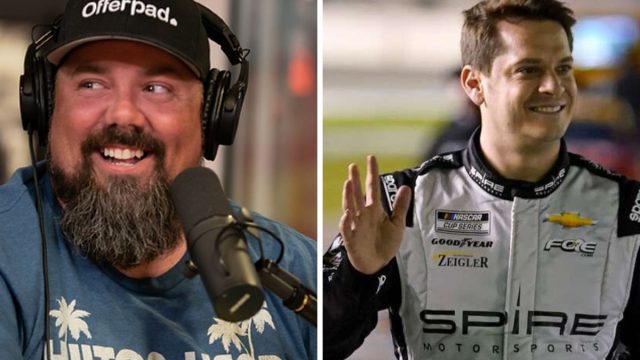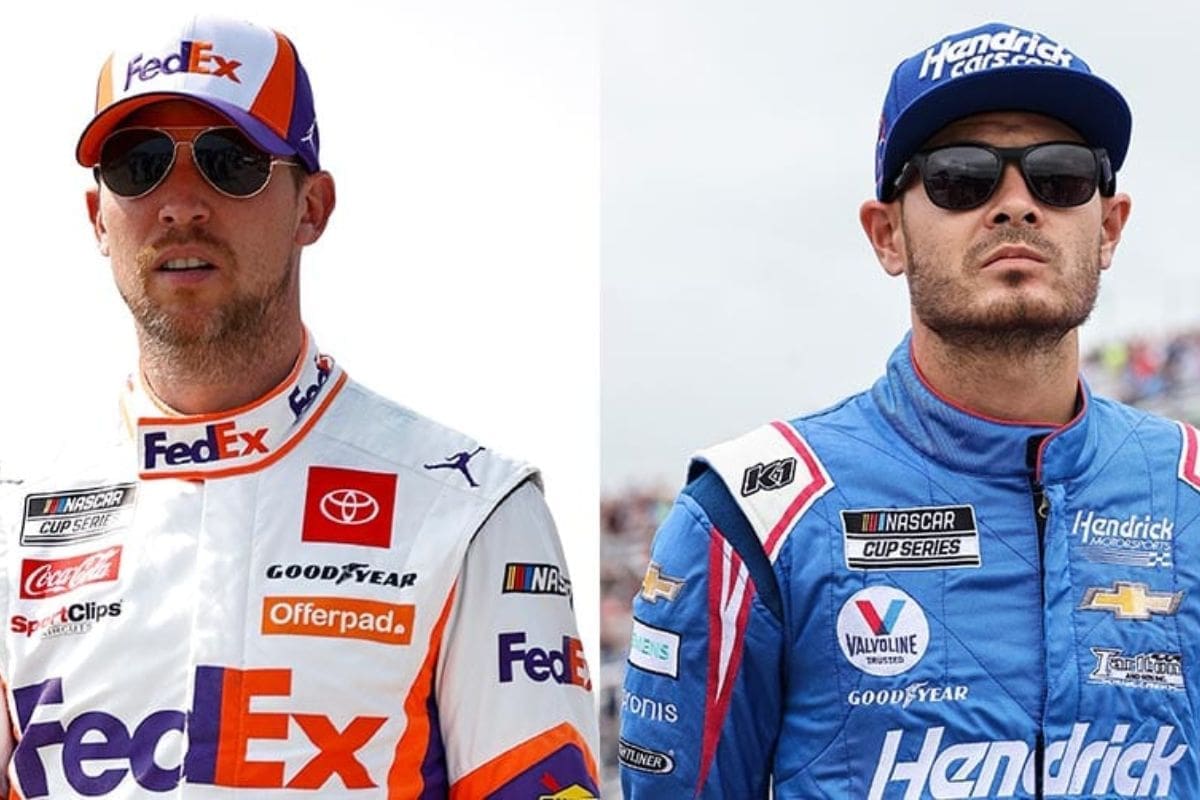Freddie Kraft Slams Landon Cassill: In NASCAR racing, emotions often run as hot as the engines. Recently, Freddie Kraft, the spotter for Bubba Wallace, sparked controversy by labeling fellow NASCAR competitor Landon Cassill an “idiot” following Cassill’s public complaints about aero-blocking tactics during a race. This incident not only shows the intense pressures and strategic complexities inherent in top-tier motorsports but also raises questions about the professionalism and communication protocols between drivers and spotters. As the community weighs in on Kraft’s harsh critique, one wonders how this will affect team dynamics and perceptions of race strategy integrity in future competitions.
Key Takeaways
- Freddie Kraft criticized Landon Cassill, labeling him an ‘idiot’ in a public dispute.
- The conflict may stem from differing views on aero-blocking and spotter roles in NASCAR.
- Cassill’s recent critique of spotters’ involvement in races possibly provoked Kraft’s harsh response.
- This incident highlights ongoing tensions regarding race strategies and safety in NASCAR.
- The dispute reflects broader debates within NASCAR on balancing technology, strategy, and driver skills.
Aero-blocking Controversy Takes Center Stage at Dover
At Dover Motor Speedway, the prominent use of aero-blocking sparked significant controversy during the latest NASCAR Cup Series race. The Next-Gen cars, designed to improve competition, have accidentally amplified the challenges of overtaking on shorter tracks such as Dover’s one-mile oval. This issue was particularly highlighted as drivers struggled to navigate the aerodynamic turbulence created by leading vehicles, which effectively blocked following cars from advancing—an effect known as aero-blocking.
Aero-blocking occurs when the leading car disrupts the airflow needed for a following car to maintain speed and maneuverability. At Dover, this phenomenon was especially pronounced, leading to a race that many viewed as less competitive and more processional. Critics argue that this diminishes the sport’s emphasis on driver skills and reduces the entertainment value for fans.
Denny Hamlin, the race winner, was overshadowed by discussions focusing on the tactical use of aero-blocking, overshadowing individual driving skills and strategic race management. The debate was further fueled by comments from race car driver Landon Cassill, who publicly criticized the over-reliance on this tactic. His remarks resonated within the racing community, drawing attention to the broader implications for race strategy and viewer engagement.
Are Spotters Making Races Mundane?
The role of spotters in NASCAR Cup Series races has come under scrutiny, with critics arguing that their extensive involvement might be diminishing the excitement of the sport. While spotters play a critical role in ensuring driver safety by providing real-time information about the positions of other cars, some members of the racing community believe that their strategic contributions, particularly in blocking maneuvers, have made races more predictable and less competitive.
In NASCAR, the issue of blocking at Dover has sparked some serious discussion. Kyle Larson, a notable figure in the Cup Series, expressed his concern about how easy it is to block on the track. He suggested that NASCAR should take action to address this problem. Larson proposed getting rid of rear cameras to increase difficulty. But Landon Cassill took it a step further. He suggested that spotters, whose job is to guide drivers, should focus solely on safety rather than informing them about other drivers’ positions. This idea didn’t sit well with Bubba Wallace’s spotter, Freddie Kraft who voiced his disagreement.
“I would be supportive of this and even go as far as finding a way to reduce the spotter’s role to safety only. But I do love our spotters, so I will take the heat for this comment.” Cassil
Opposing this perspective, some spotters and drivers argue that the strategic element spotters bring is vital for understanding the complex dynamics of NASCAR racing, where grasping aerodynamics and car positioning can be the difference between winning and losing. They contend that removing or limiting this aspect could lead to more on-track incidents, as drivers may not be as well-informed about their surroundings.
“To keep my guy “safe” in gonna help him. Aero block to keep other drivers from getting next to us. We learned today it’s much safer running single file. #WhatAnIdiot.” Kraft
To keep my guy “safe” in gonna help him
aero block to keep other drivers from getting next to us.We learned today it’s much safer running single file. #WhatAnIdiot 😉😂 https://t.co/TXJ7WK0gyS
— Freddie Kraft (@FreddieKraft) April 28, 2024
Blocking Expert Kyle Larson Unhappy after Denny Hamlin Does the Same
Reflecting on the role of spotters and strategic maneuvers in NASCAR, it is striking how Kyle Larson, a self-professed practitioner of aero-blocking, expressed dissatisfaction when Denny Hamlin employed the same tactics against him in a recent race. This incident throws a spotlight on the dynamics of racecraft in the Next-Gen era of NASCAR, where aero-blocking has emerged as a pivotal strategy. The technique, which involves positioning a car in such a way as to disrupt the airflow of a pursuing vehicle, effectively impede its ability to maintain speed and maneuverability.
Air blocking was, once again, a topic after the race on pit road. Kyle Larson suggests NASCAR should get rid of the rear view cameras to at least make it a little harder to air-block people. He used the word "easy" several times in describing the air-blocking technique.
— Jeff Gluck (@jeff_gluck) April 28, 2024
During the competition at Dover, Larson, who drives for Hendrick Motorsports, found himself unable to close the gap on Hamlin towards the critical closing laps. Larson’s previous endorsements of aero-blocking when in the lead adds intrigue to his complaints; it appears that the racer was confronted with the frustrations of a tactic he himself has capitalized on. This scenario shows a broader issue within NASCAR’s current framework—the increasing reliance on aerodynamics for defensive driving rather than overtaking skill.
Larson’s Frustration and Hamlin’s Defense
Facing mounting frustration, Kyle Larson criticized Denny Hamlin’s strategic use of aero-blocking during the recent NASCAR race at Dover, highlighting a growing tension between competitive tactics and driver skills. Larson’s vexation was noticeable as he struggled to overcome the aerodynamic challenges posed by Hamlin’s maneuvers, which effectively shielded Hamlin from overtaking attempts.
Larson expressed his difficulty in maneuvering around Hamlin, noting that even minor proximity to Hamlin’s car limited his own vehicle’s performance due to aerodynamic effects. Despite his efforts to adjust his driving style and experiment with different speeds and angles, Larson found it impossible to gain sufficient momentum to make a decisive move. This situation showed the critical role of aerodynamics in modern racing, where the physical positioning of cars relative to one another can dramatically affect their speed and handling.
“I knew when I got within three car lengths, he was going to start moving around. I just couldn’t really do anything. I was trying all sorts of different angles and speeds and all that. Nothing could generate enough speed to get close enough to do anything.” Larson
“Good points day, but we would have loved to get a win. Always fast here at Dover and we need to be a little better on the restarts.” Larson
What’s the Solution to Aero-blocking?
How can NASCAR effectively address the controversial tactic of aero-blocking to improve the competitiveness and fairness of races? Aero-blocking, where drivers manipulate air flow to hinder competitors’ progress, remains a prominent strategy despite its divisive nature among teams and fans. To tackle this issue, NASCAR could consider several strategic and technical adjustments.
Firstly, implementing more stringent regulations on car designs specifically around the aerodynamics could limit the effectiveness of aero-blocking. By standardizing certain elements of the car’s body that greatly influence airflow, such as the rear spoiler and front splitter, NASCAR could reduce the ability of a car to disrupt the air needed for close racing. This approach would require detailed aerodynamic analysis and collaboration with teams to make sure changes do not negatively impact the overall performance of the cars.
Secondly, enhancing the penalty system for drivers who are found to be excessively using aero-blocking tactics could act as a deterrent. This would involve clearer definitions of what constitutes aero-blocking and the circumstances under which penalties would apply. The enforcement of such rules would need to be consistent and transparent to maintain credibility among drivers and fans.
Lastly, NASCAR could invest in advanced simulation technologies to better understand and mitigate the impacts of aero-blocking. By using sophisticated modeling, the organization can predict how proposed changes to car designs might influence race dynamics under different conditions, thereby fine-tuning regulations before they are implemented.
News in Brief: Freddie Kraft Slams Landon Cassill
The controversy surrounding aero-blocking in NASCAR exemplified by the recent dispute between Freddie Kraft and Landon Cassill shows the complex dynamics and strategic intricacies integral to modern racing.
As stakeholders continue to express varied opinions on the role and impact of spotters and defensive driving tactics, it becomes crucial to reassess the regulations governing these practices.
Striking a balance between competitive fairness and strategic complexity is pivotal to safeguard the integrity and excitement of NASCAR events.
Our Reader’s Queries
Q. Who does Freddy Craft spot for?
A. Freddie Kraft, the spotter for Bubba Wallace’s #23 Toyota at 23XI Racing in the NASCAR Cup Series, brings an informative and direct approach to his updates. His communication style mirrors the clarity and precision expected in the fast-paced world of motorsports reporting. With a focus on delivering essential details efficiently, Kraft ensures fans stay abreast of the latest developments on the track. His updates, akin to the approach of seasoned journalist Bob Pockrass, adhere to a neutral tone, allowing the facts to speak for themselves and enabling readers to stay informed without personal bias or opinion.
Q. Is Landon Cassill still racing NASCAR?
A. Landon Cassill’s absence from the Kaulig Racing No. 10 car for the entire 2023 NASCAR Xfinity Series season has been confirmed. Cassill himself announced this development via Twitter on Wednesday morning, expressing his intention to continue his racing endeavors. In a succinct tweet, Cassill conveyed his disappointment, stating, “Unfortunately, I won’t be driving the 10 car full time this year.” This departure marks a notable shift in the team’s lineup, leaving fans and observers to speculate on potential replacements and the impact on Kaulig Racing’s performance in the upcoming season.
Q. Who is Landon Cassill driving for?
A. Landon Cassill’s transition to Kaulig Racing, in partnership with a crypto platform, has been confirmed. The announcement, reported by The Athletic, outlines Cassill’s role as the driver of the No. 96 Toyota for Gaunt Brothers Racing in forthcoming Cup Series events at Daytona and Talladega. This move underscores the evolving landscape of sponsorships and partnerships within NASCAR, as crypto platforms increasingly find their place in the sport. Cassill’s involvement with Kaulig Racing signals a strategic shift for both the driver and the team, sparking anticipation among fans and industry insiders alike for their performance in the upcoming races.
ALSO READ: Freddie Kraft Slams Talladega Race: ‘They’re Not Racing’



